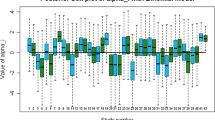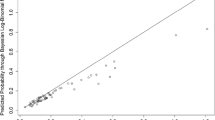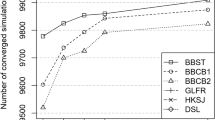Abstract
In meta-analysis of rare-event outcomes, an additional statistical consideration is necessary due to the occurrence of studies with no event. The traditional approaches of adding a correction factor or omitting these studies are known to result in misleading conclusions. Furthermore, studies involved in the meta-analysis often report results for more than one outcome. Bivariate meta-analysis is known as a promising approach for jointly combining two outcomes whilst incorporating correlations between outcomes. However, there has not been sufficient discussion on a bivariate extension in the context of meta-analysis for rare-event outcomes. We consider a joint synthesis of two binary outcomes with low incidence, and propose a novel bivariate meta-analysis method using copula. The method assumes marginal beta-binomial distributions for the two outcomes, and links these margins by a bivariate copula which identifies an overall dependence structure between outcomes. A simulation study suggested that the method could provide a robust estimation for the incidence of rare events and have potential benefits of bivariate meta-analysis such as an improvement of precision of pooled estimates. We illustrated the method through an application to a meta-analysis of 48 studies that evaluated a potential risk of rosiglitazone on myocardial infection and cardiovascular death.












Similar content being viewed by others
References
Barnett, V. (1980). Some bivariate uniform distributions. Communications in Statistics—Theory and Methods, 9, 453–461.
Bennetts, M., Whalen, E., Ahadiehc, S., & Cappelleri, J. C. (2017). An appraisal of meta-analysis guidelines: How do they relate to safety outcomes? Research Synthesis Methods, 8, 64–78.
Berlin, J. A., Crowe, B. J., Whalen, E., Xia, H. A., Koro, C. E., & Kuebler, J. (2013). Meta-analysis of clinical trial safety data in a drug development program: Answer to frequently asked questions. Clinical Trials, 10, 20–31.
Bohning, D., Mylona, K., & Kimber, A. (2015). Meta-analysis of clinical trials with rare events. Biometrical Journal, 4, 633–648.
Bradburn, M. J., Deeks, J. J., Berlin, J. A., & Localio, A. R. (2007). Much ado about nothing: A comparison of the performance of meta-analytical methods with rare events. Statistics in Medicine, 26, 53–77.
Cai, T., Parast, L., & Ryan, L. (2010). Meta-analysis for rare events. Statistics in Medicine, 29, 2078–2089.
Chen, Y., Hong, C., Ning, Y., & Su, X. (2016). Meta-analysis of studies with bivariate binary outcomes: A marginal beta-binomial model approach. Statistics in Medicine, 35, 21–40.
Cheng, J., Pullenayegum, E., Marshall, J. K., Iorio, A., & Thabane, L. (2015). Impact of including or excluding both-armed zero-event studies on using standard meta-analysis methods for rare event outcome: A simulation study. British Medical Journal Open, 6, e010983. https://doi.org/10.1136/bmjopen-2015-010983.
Chu, H., Nie, L., Chen, Y., Huang, Y., & Sun, W. (2012). Bivariate random effects models for meta-analysis of comparative studies with binary outcomes: Methods for the absolute risk difference and relative risk. Statistical Methods in Medical Research, 21, 621–633.
Clayton, D. (1978). A model for association in bivariate life tables and its application in epidemiological studies of family tendency in chronic disease incidence. Biometrika, 65, 141–151.
Cook, R. D., & Johnson, M. E. (1981). A family of distributions for modeling non-elliptically symmetric multivariate data. Journal of the Royal Statistical Society: Series B, 43, 210–218.
Frank, M. J. (1979). On the simultaneous associativity of F(x, y) and x + y-F(x, y). Aequationes mathematicae, 21, 194–226.
Friedrich, J. O., Adhikari, N. K. J., & Beyene, J. (2007). Inclusion of zero total event trials in meta-analyses maintains analytic consistency and incorporates all available data. BMC Medical Research Methodology, 7, 5.
Gumbel, E. J. (1960). Bivariate exponential distributions. Journal of the American Statistical Association, 55, 698–707.
Hammad, T. A., Laughren, T., & Racoosin, J. (2006). Suicidality in pediatric patients treated with antidepressant drugs. Archives of General Psychiatry, 63, 332–339.
Higgins, J. P. T., & Green, S. (editors). (2011). Cochrane Handbook for Systematic Reviews of Interventions Version 5.1.0 [updated March 2011]. The Cochrane Collaboration.
Hoyer, A., & Kuss, O. (2015). Meta-analysis of diagnostic tests accounting for disease prevalence: A new model using trivariate copulas. Statistics in Medicine, 34, 1912–1924.
Jackson, D., Riley, R. D., & White, I. R. (2011). Multivariate meta-analysis: Potential and promise. Statistics in Medicine, 30, 2481–2498.
Joe, H. (2014). Dependence modeling with copulas. London: Chapman and Hall/CRC.
Kirkham, J. J., Riley, R. D., & Williamson, P. R. (2012). A multivariate meta-analysis approach for reducing the impact of outcome reporting bias in systematic reviews. Statistics in Medicine, 31, 2179–2195.
Kuss, O. (2015). Statistical methods for meta-analyses including information from studies without any events-add nothing to nothing and succeed nevertheless. Statistics in Medicine, 34, 1097–1116.
Kuss, O., Hoyer, A., & Solms, A. (2014). Meta-analysis for diagnostic accuracy studies: A new statistical model using beta-binomial distributions and bivariate copulas. Statistics in Medicine, 33, 17–30.
Lane, P. W. (2011). Meta-analysis of incidence of rare events. Statistical Methods in Medical Research, 22, 117–132.
Loke, Y. K., Price, D., & Herxheimer, A. (2011). Chapter 14: adverse effects. In Higgins, J.P.T., Green, S. (eds.), Cochrane Handbook for Systematic Reviews of Interventions. Version 5.1.0. The Cochrane Collaboration. www.handbook.cochrane.org. Updated March, 2011.
Mavridis, D., & Salanti, G. (2013). A practical introduction to multivariate meta-analysis. Statistical Methods in Medical Research, 22, 133–158.
Nelsen, R. B. (2006). An introduction to copulas (2nd ed.). New York: Springer.
Nikoloulopoulos, A. K. (2015a). A mixed effect model for bivariate meta-analysis of diagnostic test accuracy studies using a copula representation of the random effects distribution. Statistics in Medicine, 34, 3842–3865.
Nikoloulopoulos, A. K. (2015b). A vine copula mixed effect model for trivariate meta-analysis of diagnostic test accuracy studies accounting for disease prevalence. Statistical Methods in Medical Research. https://doi.org/10.1177/0962280215596769.
Nissen, S. E., & Wolski, K. (2007). Effect of rosiglitazone on the risk of myocardial infarction and death from cardiovascular causes. New England Journal of Medicine, 356, 2457–2471.
Nissen, S. E., & Wolski, K. (2010). Rosiglitazone revisited: An updated meta-analysis for myocardial infarction and cardiovascular mortality. Archives of Internal Medicine, 170, 1191–1201.
Oakes, D. (1982). A model for association in bivariate survival data. Journal of the Royal Statistical Society: Series B, 44, 414–422.
Riley, R. D. (2009). Multivariate meta-analysis: The effect of ignoring within-study correlation. Journal of the Royal Statistical Society: Series A, 172, 789–811.
Riley, R. D., Abrams, K. R., Lambert, P. C., Sutton, A. J., & Thompson, J. R. (2007). An evaluation of bivariate random-effects meta-analysis for the joint synthesis of two correlated outcomes. Statistics in Medicine, 26, 78–97.
Riley, R. D., Thompson, J. R., & Abrams, K. R. (2008). An alternative model for bivariate random-effects meta-analysis when the within-study correlations are unknown. Biostatistics, 9, 172–186.
Rucker, G., Schwarzer, G., Carpenter, J. R., & Olkin, I. (2009). Why add anything to nothing? The arcsine difference as a measure of treatment effect in meta-analysis with zero cells. Statistics in Medicine, 28, 721–738.
Shuster, J. J. (2010). Empirical vs natural weighting in random effects meta-analysis. Statistics in Medicine, 29, 1259–1265.
Shuster, J. J., Guo, J. D., & Skyler, J. S. (2012). Meta-analysis of safety for low event-rate binomial trials. Research Synthesis Methods, 3, 30–50.
Shuster, J. J., Jones, L. S., & Salmon, D. A. (2007). Fixed vs random effects meta-analysis in rare event studies: The rosiglitazone link with myocardial infarction and cardiac death. Statistics in Medicine, 26, 4375–4385.
Shuster, J. J., & Walker, M. A. (2016). Low-event-rate meta-analyses of clinical trials: Implementing good practices. Statistics in Medicine, 35, 2467–2478.
Sklar, A. (1973). Random variables, joint distributions, and copulas. Kybernetica, 9, 449–460.
Song, P. X.-K. (2000). Multivariate dispersion models generated from Gaussian copula. Scandinavian Journal of Statistics, 27, 305–320.
Song, P. X.-K., Li, M., & Yuan, Y. (2009). Joint regression analysis of correlated data using Gaussian copulas. Biometrics, 65, 60–68.
Spittal, M. J., Pirkis, J., & Gurrin, L. C. (2015). Meta-analysis of incidence rate data in the presence of zero events. BMC Medical Research Methodology. https://doi.org/10.1186/s12874-015-0031-0.
Stijnen, T., Hamza, T. H., & Ozdemir, P. (2010). Random effects meta-analysis of event outcome in the framework of the generalized linear mixed model with applications in sparse data. Statistics in Medicine, 29, 3046–3067.
Sweeting, M., Sutton, A. J., & Lambert, P. C. (2004). What to add to nothing? Use and avoidance of continuity corrections in meta-analysis of sparse data. Statistics in Medicine, 23, 1351–1375.
Tian, L., Cai, T., Pfeffer, M. A., Piankov, N., Cremieux, P. Y., & Wei, L. J. (2009). Exact and efficient inference procedure for meta-analysis and its application to the analysis of independent 2 × 2 tables with all available data but without artificial continuity correction. Biostatistics, 10, 275–281.
Yusuf, S., Peto, R., Lewis, J., Collins, R., & Sleight, P. (1985). Beta blockade during and after myocardial infarction: An overview of the randomized trials. Progress in Cardiovascular Disease, 27, 335–371.
Author information
Authors and Affiliations
Corresponding author
Ethics declarations
Conflict of interest
On behalf of all authors, the corresponding author states that there is no conflict of interest.
Additional information
Publisher's Note
Springer Nature remains neutral with regard to jurisdictional claims in published maps and institutional affiliations.
Rights and permissions
About this article
Cite this article
Yamaguchi, Y., Maruo, K. Bivariate beta-binomial model using Gaussian copula for bivariate meta-analysis of two binary outcomes with low incidence. Jpn J Stat Data Sci 2, 347–373 (2019). https://doi.org/10.1007/s42081-019-00037-z
Received:
Accepted:
Published:
Issue Date:
DOI: https://doi.org/10.1007/s42081-019-00037-z




